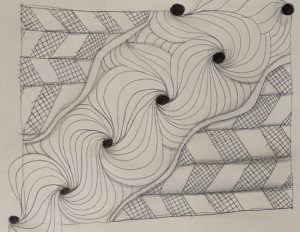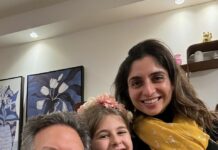In the throes of busy day-to-day life, it can be difficult to take a moment and practice mindfulness, especially while still acknowledging Jewish tenets and the Torah. With their Zentangling program, The Soul Center at Beth El Congregation of Baltimore hopes to provide people with a moment of respite while putting a uniquely Jewish twist on the meditative doodling practice.

Zentangling itself was started by Rick Roberts and Maria Thomas in 2003 when they noticed similarities between the state of calmness experienced while drawing and meditation. Zentangle illustrations are characterized by their abstract geometry and focus on simple patterns, and do not require any artistic skill — only the ability to follow along with a Zentangling instructor.
“If you can write your name, you can Zentangle,” said Kathy Shapiro, one of the teachers of the Soul Center Zentangling program. “If you can draw a straight line or a circle, you can Zentangle.”
Shapiro leads Zentangling programs on Wednesdays, with her colleague Dr. Sarah Reading subbing in on Sundays. Shapiro is actually an experienced calligrapher, which is what led Beth El Rabbi Dana Saroken to suggest a Zentangling program to her a few years ago.
Initially, the classes were held in person at the Soul Center itself, and attendance was fairly small. A typical Zentangling class would consist of 10 to 20 people. The COVID-19 pandemic forced the classes to move to a virtual format on Zoom.
But this proved to be a great boon to the program rather than a disadvantage. The virtual nature of the class made it more accessible to those who could not make it to the Soul Center, such as those who live in different states or even different countries. Two years into the new Zoom format, the center’s Zentangling classes are frequently attended by 100 or more.
“We ended up in people’s homes and corners of the world we’ve never imagined.” Shapiro said.
On the appeal of Zentangling as opposed to other meditative processes, she added, “With [things like] yoga, there’s nothing to show a friend when you’re done except your glow. After you tangle, you have something you often want to share like this with friends and family because it’s so gorgeous.”
Her colleague, Reading, is a psychiatrist and notes that meditative practices like Zentangling can have a positive effect on a person’s mental state. “After spending a career studying and working to understand mental illness I came to realize how little I knew about mental wellness,” she said. “I had too few tools to help them move beyond getting better and onward into something more ongoing. … Zentangle provides a tool to exhale and find a moment of mastery in the complicated and overstimulated world we’ve come to know.”
Some people tangle to cope with trauma or other negative events in their life, using the process as an escape or a moment of reflection. It is not a cure-all for anyone’s problems, but the opportunities for awareness and clarity it provides can be much-needed.
“It has a way of attracting people who are going through important transitions in their lives,” Shapiro said. “People dealing with grief, dealing with cancer and illnesses of different kinds. And it has helped heal and provide beauty and comfort for people going through cancer treatment and stages of loss and great stressors.”
The Soul Center puts a Jewish spin on Zentangling by implementing a “Torah Tangle”: a discussion about the week’s Torah portion and how it ties into the themes of mental health and mindfulness associated with tangling.
For example, the July 24 class focused on the idea of splitting one’s life into 42 chapters, deciding which events are most important and looking back at personal experiences to see how they affected or changed a person. This was inspired by the 42 stops that the Israelites made on their 40-year journey to Israel. The Baal Shem Tov once said each Jewish person’s life is a 42-step journey, which is what the session was spent reflecting on.
“You don’t have to be an artist to Zentangle, and you don’t have to be a Torah scholar to study Torah,” said Naomi Malka, the Soul Center’s managing director. “You can still take the themes in, and I learned so much from them. … Exploring the overlap [between Zentangle and Torah philosophy] is a really beautiful opportunity. We are channeling our love of Torah and our love of this practice at the same time.”
The Zentangling classes are open to all, regardless of art ability or denomination. They only require paper, a pencil and a black ink pen. Each session is free and occurs twice a week on Sundays and Wednesdays at 3 p.m.
“There is something innately human in the impulse and joy in ‘making’ things … in drawing,” Reading said. “There is a thrill for many adults to return to the ‘childish’ practice of drawing. … The trick of it is to simply enjoy it — no judgment allowed and no mistakes possible.”







